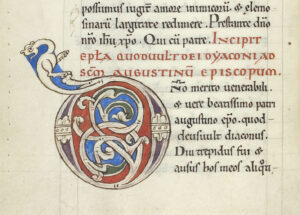
Please join us in welcoming this year’s Mediaevalia speaker, Dr. Erik Kwakkel, Associate Professor in medieval manuscript studies at Leiden University, The Netherlands, and principal investigator of the research project ‘Turning Over a New Leaf: Manuscript Innovation in the Twelfth-Century Renaissance’. Among his publications are articles and book chapters on a variety of manuscript-related topics, as well as monographs and edited volumes on Carthusian book production (2002), medieval Bible culture (2007), change and development in the medieval book (2012), medieval authorship (2012), and Insular book culture (2013). Dr. Kwakkel was the 2014 E.A. Lowe Lecturer in Paleography at Corpus Christi College, Oxford.
Dr. Kwakkel will be presenting two programs:
Kissing the Neighbor: How Medieval Letterforms Help to Tell Time
When: Thursday, March 27, 2014 5:00-7:00 PM
Where: Lilly Library Lincoln Room
What: Lecture and reception. All are welcome.
“Age is not important, unless you are a cheese.” Historians know this expression not to be true: the age of a piece of writing matters a great deal. The key to determining when a given medieval manuscript was written is to assess the age of its script. The handwriting of scribes developed continuously, meaning that their products can be placed in time if the right reference points are available. This paper deals with such reference points: it shows that developing letterforms provide evidence for dating the book in which they appear; and how we may retrieve this information. The main focus will be on what is arguably the most dramatic development in medieval handwriting: the shift from Caroline to Gothic script. During the century and half of this transformation, in an age known as The Long Twelfth Century, scribes across Europe began to search for new ways of executing letters. Neighboring letters began to ‘kiss’ and ‘bite’ each other, while the ‘i’ became dotted and the ‘t’ crossed. The lecture ultimately demonstrates it is possible to gauge the date of a manuscript in an objective manner: it shows how letterforms help to tell time.
Why Study the Medieval Book?
When: Friday, March 28, 2014 9:00AM—12:00 Noon
Where: The Lilly Library Slocum Room
What: Hands-on workshop for graduate students and faculty
**Enrollment is limited to 16 participants and pre-registration is required. Please contact Cherry Williams, Curator of Manuscript, The Lilly Library for information and to register: chedwill@indiana.edu
This workshop focuses on the medieval manuscript as a physical object. It aims to show faculty and students how its features matter for studies that are not primarily interested in the material book itself. It queries how someone working in the disciplines of English, History or Religious Studies, etc. may benefit from a manuscript beyond merely the text it holds on its pages. The workshop will present ‘real-world’ case studies to show how even someone with a basic understanding of the medieval book may benefit from its physical features. At the end of the session participants will be able to answer the query posed in the workshop’s title.